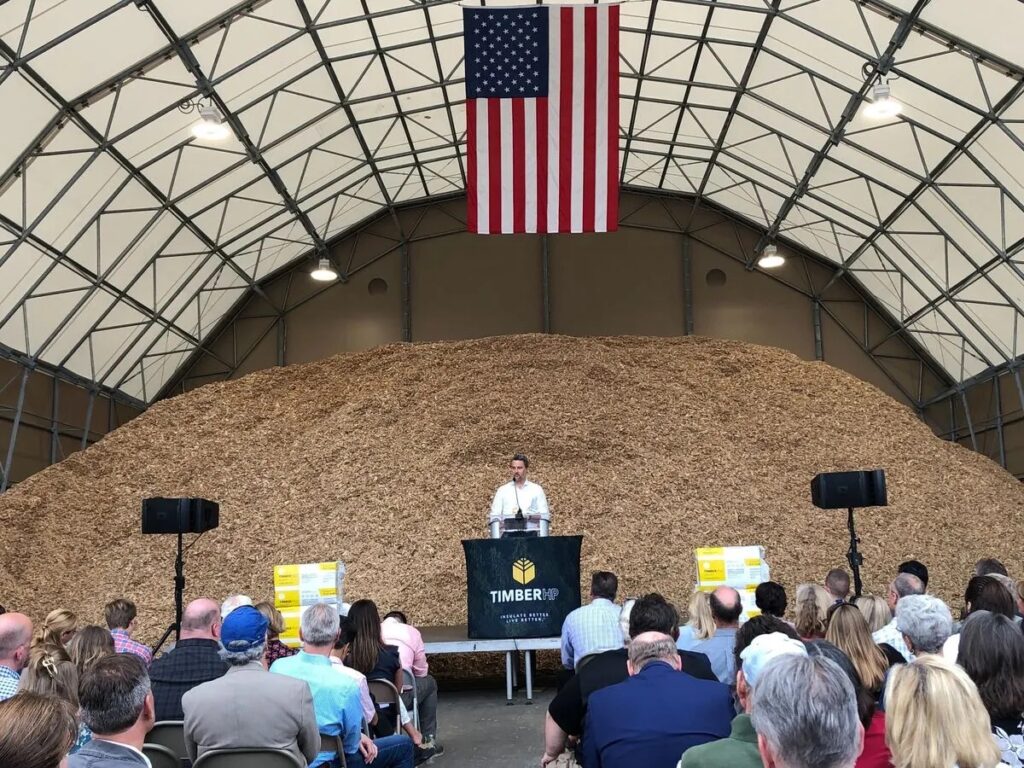This Maine-made wood insulation is starting to catch on
Originally posted by Bangor Daily News on February 7th, 2024
Wood fiber insulation, made for the first time in North America by Madison manufacturer TimberHP, promises to be the next big thing in Maine construction.
The insulation is more sustainable than materials like foam. It is made using logging waste and sequesters carbon as well as cellulose insulation. Priced somewhere between mineral wool and fiberglass, it is a competitive option as construction costs continue to climb. Wood fiber also doesn’t trap moisture like plastic insulation does, which can rot a building out.
Production of TimberHP’s first product, a blown-in insulation, began last summer in Madison’s old paper mill. It is just starting to catch on. A 65-unit workforce housing development in Westbrook is using it. The College of the Atlantic in Bar Harbor has installed it in two buildings, and the company is trying to quickly expand its use in Maine.

“As far as we’re concerned, it works better on every point. It was the same cost, it’s made in Maine, and it’s better for the environment, why wouldn’t we use it?” Jack Soley, the Portland developer who is using TimberHP’s blown-in insulation for the Westbrook development.
Avesta Housing, a Portland-based affordable housing developer, is considering using it for a couple of its projects in southern Maine, Matt O’Malia, TimberHP’s co-CEO, said.
Developers have been a little wary of using an insulation material that is practically untested here, O’Malia noted. It’s historically been viewed as a “premium sustainability product.” But the material has been popular in European construction for 20 years and is thought to have brought in $1 billion in revenue there last year, according to TimberHP.
In Maine, which is 90 percent forested, the product is cheaper to produce. Due to the shuttering of paper mills here in recent years, there is a great deal of logging waste no longer being used for pulpwood production. Cellulose, the most widely used sustainable insulation product, is made from such pulp.
“It’s a good transition from cellulose, as the market conditions have changed, to something that’s scalable going forward in the future, and can really be produced in volume.” O’Malia said.
Soley was originally going to use blown-in cellulose for his Westbrook project because of its sustainable properties, but the material would have had to be transported from “far away” to be used in Westbrook. That was an “environmental cost” Soley didn’t want to pay, he said.
TimberHP matched the price point of using cellulose insulation, Soley said. It also touted benefits like supporting Maine industry, higher heat efficiency and moisture wicking. His quote for installation costs also didn’t change once he switched to wood fiber, he said.
“It was a total no-brainer,” Soley said.
O’Malia said he sees his company’s staff of 75 eventually growing to 130 people, and the facility being open 24 hours a day and seven days a week.
The company is rolling out two more products this spring, one board and one batten-type insulation, that will diversify their offerings. To support that effort, the company was recently awarded $1 million in loans from the Finance Authority of Maine and the Maine Rural Development Authority.
At full production, the Madison plant will use around 250,000 green tons of wood annually. It’s not nearly the amount of input the facility once processed as a paper mill, but it’s still recycling refuse from logging that would otherwise have gone to waste and bringing some jobs back.
“There’s a great culture in Maine that knows how to do this kind of production and a really, really well-trained workforce,” O’Malia said. “We are definitely kind of able to plug into the legacy of that type of wood products manufacturing in Maine.”